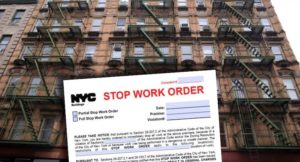
If there’s a jurisdiction taking the coronavirus-related reopening guidelines seriously, it’s NYC. The Big Apple’s Department of Building has been sending inspectors to construction sites across the city, responding to reports of safety violations from citizens and workers alike. As a result of recent inspections, the Department has issued thousands of Stop Work Orders (SWO) on construction projects, shutting down job sites across the city. These serious orders will have an effect on project timelines, workforce management, and of course, payment.
NYC Department of Buildings inspectors issue Stop Work Orders
June 8th marked the official reopening of construction sites that the city originally deemed nonessential. City inspectors began to hit the sites at that time, providing guidance and a 30-day grace period for non-compliant job sites to clean up their act.
The 30-day grace period ended on July 8th. The first five days proved action-packed for the city’s Department of Buildings Inspectors, who issued 88 citations and 41 stop-work orders by July 13th.
Department of Building press secretary, Andrew Rudanksy, suggested the show of force is in response to the city’s 311-hotline. The 311 number is not COVID-specific, as anyone can call for city-related service requests. But it’s also the main reporting system citizens use to report violations of New York’s social distancing and mask guidelines.
Many of the calls concern construction sites. They include reports of improper social distancing, PPE violations, and a lack of attention paid to cleaning protocols.
The calls received have been from vigilant citizens, concerned that lazy practices will cause a spike in local coronavirus cases. More surprisingly, many of these calls are coming from construction workers. They call on construction sites if they feel their personal safety is at risk.
How a Stop Work Order affect construction projects
While the name is pretty self-explanatory, it doesn’t tell the whole story. The NYC DOB issues Stop Work Orders on job sites for various reasons. Most often, the inspectors issue SWOs on job sites deemed unsafe or for egregious violations of safety codes and regulations.
Full Stop vs. Partial Stop
Stop Work Orders come in two flavors: Full Stop and Partial Stop. While partial stops are often practical for safety violations, full stops are most likely the penalty for coronavirus-related SWOs.
Penalties for the violations leading to an SWO are $5,000 for the first offense and $10,000 for subsequent violations.
To have your SWO lifted, you need to correct the violations and make the site safe, submit a Certificate of Correction, and request a re-inspection. Also, you’ll have to pony up the penalty fees.
Slow contractor payments
The forced shut-down of a construction site affects everyone involved, and it can sting their bank accounts. Under a Partial Stop, you may be able to stay on course, but there may be an increase in inspections and a less pleasant working environment.
If you’re on a site and an inspector issues a Full Stop Work Order, you’ll need to pack up your tools until they lift it. Every day that you aren’t working brings you closer to your contract’s deadline, possibly placing you in breach of contract. Unless you’re the violator, however, you may have some flexibility or protection afforded to you in your contract.
Also, every day you’re unable to work extends your timeline, affecting your progress payments and the interest you owe to the supply house. The longer you have to float cash on a project, the more expensive that job becomes. That time gone-by will shrink your profit margin.
If you’ve completed work and you’re waiting for payment, there’s a good chance your pay app is sitting on the GC’s desk. They’re unlikely to see it while they scramble to handle the violations and reopen the site.
Contractors that cause the violations are in a different boat altogether. It’s unlikely that their contract will protect them from a breach of contract. Also, the site owner may be able to sue them for the issues caused by the violation.

Need to file a Mechanics Lien?
We’re the Mechanics Lien experts. With us it’s fast, easy, affordable, and done right.
File NowHow to avoid payment problems caused by a Stop Work Order
You can’t control other people, but you can control your crew. The best way to avoid a Stop Work Order is to ensure your crew complies with COVID-related guidelines and general job site safety regulations. This includes proper PPE, social distancing, and adequate sanitation. While compliance does carry a cost, it’s likely significantly less than potential penalties or payment delays from a jobsite closure.
On top of regular jobsite precautions and compliance with coronavirus regulations, you should be protecting your payments. Even if a jobsite is shut down, participants still have a right to receive payment for work or materials they have already furnished.
For most construction professionals, filing a mechanics lien is the most effective way to speed up your payment, especially for those experiencing delays.